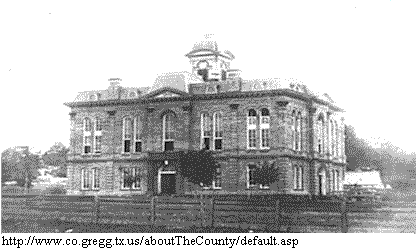The Caddo Indians originally inhabited the territory that became Gregg County for several centuries. Sometime in the seventeenth or eighteenth centuries, Cherokee Indians expelled the Caddos and lived there until Anglos removed the Cherokees in 1800. One of the signature historical pieces of Gregg County is the Cherokee Trace, the trailed used by the Cherokees to move to new lands after Texas President Mirabeau Lamar removed them in 1838. In 1835, the Spanish government granted partitions of land to those who settled on the land. After the Texas War of Independence, the Texas governments acknowledged the grants from the Spanish. 
The area of Gregg County was not created by the Texas Legislature until 1873. The legislature proposed the first name of the county to be Roanoke, but nothing became of it; instead, the legislature named the county after Confederate soldier John B. Gregg on April 30, 1874. Gregg County's main income came from cotton, corn, timber, and farming production from the 1880s to the 1930s.
Like other places in Texas and the United States, Gregg County suffered economically through the Great Depression, but the discovery of oil in 1931 altered the financial outlook of the Gregg County. The oil boom died out in the 1940s, and employment numbers hit a low in 1982 as a result. After unemployment figures skyrocketed, the economy leveled out with tourism, agribusiness, and manufacturing producing steady income for the county. The twenty-first century marked an increase in the production of oil, gas, and timber.
Genealogy
- Aaron Burleson Chapter, DAR
- Captain William Young Chapter, DAR
- East Texas Chapter 57, SAR
- Gregg County Genealogical Society
- Gregg County Historical and Genealogical Society
- R. B. Levy Chapter 1070, UDC
- Samuel Paul Dinkins Chapter, DAR
Library/Archive
City/State/Federal Agency
Historical Association/Organization
Museum/Historical Site
- Gregg County Historical Museum
- Longview Museum of Fine Arts
- St. Clair Museum of Gladewater
- East Texas Oil Museum
Text: http://www.tshaonline.org/handbook/online/articles/hcg10 Handbook of Texas Online, Texas State Historical Association
To learn more about Gregg County's history check out our Local Voices' writer Van Craddock's column "Gregg County Tales" on our Local Voices page.